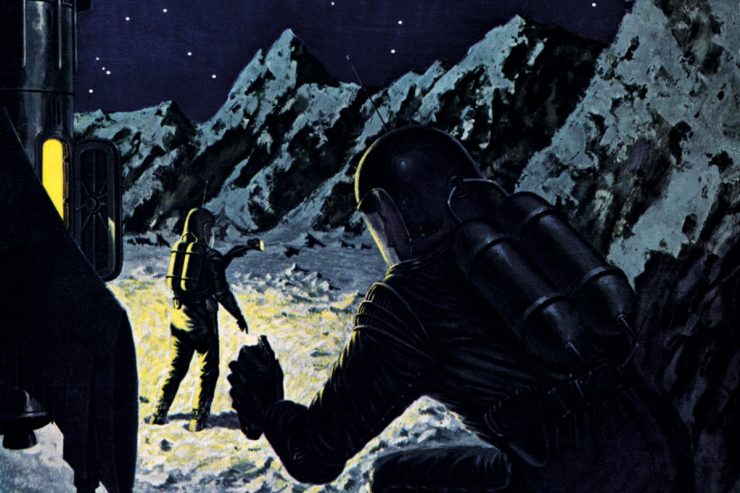Pulp magazines have influenced writers, artists, film directors, software developers, and countless others over the years. Our “PulpFest Historical” articles focus on the rough-paper writers, editors, publishers, and artists who have inspired and continue to inspire the creators of the world’s popular culture.
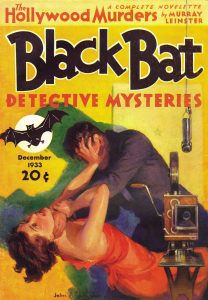 Today we celebrate the 125th birthday of TIME magazine’s “dean of science fiction writers,” William Fitzgerald Jenkins — a.k.a. Murray Leinster. An avid inventor who also happened to have a knack for writing wonderful speculative science fiction, his career spanned much of the 20th century.
Today we celebrate the 125th birthday of TIME magazine’s “dean of science fiction writers,” William Fitzgerald Jenkins — a.k.a. Murray Leinster. An avid inventor who also happened to have a knack for writing wonderful speculative science fiction, his career spanned much of the 20th century.
Would you believe that it was Jenkins who originally patented the filming method we know today as “green screen?” How about the fact that his first science fiction story was published before the term “science fiction” was in popular use? And that Leinster continued to publish stories into the early 1970s? It’s all true!
Jenkins was a legend who not only contributed to the field of science fiction but created entirely new subgenres within that field. He won both the Hugo (1956) and Retro-Hugo (1996) Award. He also had a new award named for one of his stories — the Sidewise Award for Alternate History. There’s even a special day designated as “Will F. Jenkins Day” in his home state of Virginia. Murray Leinster wrote and published more than 1,500 short stories and articles, fourteen movie scripts, and hundreds of radio scripts and television plays in his long and productive career.
Jenkins dropped out of high school and was two months shy of his 20th birthday when his first story, “The Foreigner,” appeared in the May 1916 issue of H. L. Mencken’s literary magazine, SMART SET. Over the next three years, he published ten more stories in that magazine. It was during this time that he started using the pseudonym — Murray Leinster. In an article from 1934, Jenkins states that the name came about because George Jean Nathan had flattered him.
Mr. Nathan [of SMART SET magazine] . . . suggested that I save my own name for SMART SET, and use a pseudonym for inferior publications. Flattered, I agreed. . . . Murray Leinster [was concocted] out of some family names . . . and I’ve been using it ever since because [a] it shortly acquired a trademark value superior to that of my own name and [b] because as Murray Leinster, I could say profound-seeming things without feeling quite so much an ass. Murray is a wiser, kinder, more tolerant, and altogether a hell of a better scout than I am.
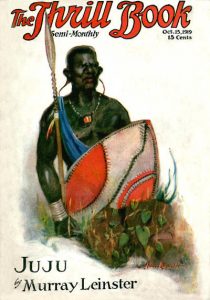 During and after World War I, his work began appearing in pulp magazines including ARGOSY, BREEZY STORIES, SAUCY STORIES, SNAPPY STORIES, and THE THRILL BOOK. When pulp magazines began to diversify during the 1920s, Leinster followed suit by selling jungle and adventure stories to DANGER TRAILS and ADVENTURE, westerns to WEST and COWBOY STORIES, detective stories to THE BLACK MASK and MYSTERY STORIES, horror fiction to WEIRD TALES, and even romance stories to LOVE STORY MAGAZINE. His lover stories were published under another pen name, Louisa Carter Lee. He also continued to freelance for SMART SET writing fillers, epigrams, and poems.
During and after World War I, his work began appearing in pulp magazines including ARGOSY, BREEZY STORIES, SAUCY STORIES, SNAPPY STORIES, and THE THRILL BOOK. When pulp magazines began to diversify during the 1920s, Leinster followed suit by selling jungle and adventure stories to DANGER TRAILS and ADVENTURE, westerns to WEST and COWBOY STORIES, detective stories to THE BLACK MASK and MYSTERY STORIES, horror fiction to WEIRD TALES, and even romance stories to LOVE STORY MAGAZINE. His lover stories were published under another pen name, Louisa Carter Lee. He also continued to freelance for SMART SET writing fillers, epigrams, and poems.
From 1915 to 1932 Jenkins wrote stories for pulp and science fiction magazines under the pseudonym, Murray Leinster. After 1930 he resumed the use of his own name for stories published in national magazines.
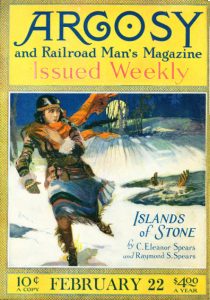 Leinster’s first published science fiction story, “The Runaway Skyscraper,” appeared in the February 22, 1919 issue of ARGOSY AND RAILROAD MAN’S MAGAZINE. In that story, a New York skyscraper plunges backward in time and its occupants are forced to rough it in the wilderness. These people must contrive a way to return to their present-day before they run out of power and supplies. The story was later reprinted by Hugo Gernsback in AMAZING STORIES.
Leinster’s first published science fiction story, “The Runaway Skyscraper,” appeared in the February 22, 1919 issue of ARGOSY AND RAILROAD MAN’S MAGAZINE. In that story, a New York skyscraper plunges backward in time and its occupants are forced to rough it in the wilderness. These people must contrive a way to return to their present-day before they run out of power and supplies. The story was later reprinted by Hugo Gernsback in AMAZING STORIES.
He soon followed with “The Mad Planet” in 1920 and its sequel, “The Red Dust” in 1921. Both were originally published in ARGOSY and later reprinted in AMAZING STORIES and FANTASTIC NOVELS. I find both these stories extremely interesting suppositions about climate change. They take place in a “greenhouse Earth” — where the levels of carbon dioxide and other greenhouse gases (such as water vapor and methane) are very high, as is the temperature. Breathable oxygen is far less than we have available today.
In this nightmare world — which slowly evolved over time and not by a single climate disaster — there are giant insects and gigantic mold and fungus forests. The humans that remain are frail and timid. They are less intelligent due to the low oxygen levels and have regressed to become the prey of the insects. One human, Burl, begins to think like a man again, not as a frightened animal. He eventually leads his people to better living conditions.
Leinster later reworked this idea, adding new elements. It was published in 1954 by Gnome Press as the novel, THE FORGOTTEN PLANET.
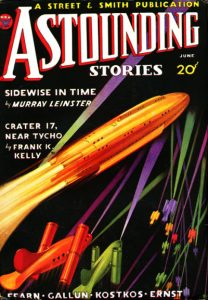 In 1934 Leinster created one of the most influential sci-fi stories ever written, “Sideways in Time.” It defined an entirely new concept — the premise of parallel realities or alternate history. These other worlds exist at the same time as ours, but in separate realities where human or natural history has taken a different course. When this story came out in ASTOUNDING STORIES nothing like it had been seen before. Leinster revisited this theme in other stories including “The Incredible Invasion,” “The Other Now,” and “Rogue Star.”
In 1934 Leinster created one of the most influential sci-fi stories ever written, “Sideways in Time.” It defined an entirely new concept — the premise of parallel realities or alternate history. These other worlds exist at the same time as ours, but in separate realities where human or natural history has taken a different course. When this story came out in ASTOUNDING STORIES nothing like it had been seen before. Leinster revisited this theme in other stories including “The Incredible Invasion,” “The Other Now,” and “Rogue Star.”
His 1945 novella, “First Contact,” includes one of the first (if not the first) instances of a universal translator used in science fiction. In 1970, it was named one of the greatest science fiction stories of all time by the members of the Science Fiction Writers of America.
Writing as Will F. Jenkins, he published “A Logic Named Joe” in 1946. This story is important as it features one of the first descriptions of a computer (called a “logic”) seen in fiction. This story is both funny and prophetic. The hectic tale envisions a logic in every home, linked through a distributed system of servers (called “tanks”) providing communications, entertainment, data access, and commerce. Some of the problems the characters encounter seem oddly familiar and make the story accessible, despite its vintage.
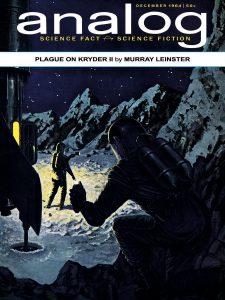 Through his Med Service series, Leinster established the subgenre of the “science fiction doctor story.” The first came out in ASTOUNDING in 1957. Each of the eight tales in the series presents an intriguing dilemma for Doctor Calhoun of the Interstellar Medical Service. He’s a no-nonsense character — part-action hero, and all scientist. Not even a pretty face can sway him from his duty which, of course, makes him all the more attractive.
Through his Med Service series, Leinster established the subgenre of the “science fiction doctor story.” The first came out in ASTOUNDING in 1957. Each of the eight tales in the series presents an intriguing dilemma for Doctor Calhoun of the Interstellar Medical Service. He’s a no-nonsense character — part-action hero, and all scientist. Not even a pretty face can sway him from his duty which, of course, makes him all the more attractive.
Leinster was one of the few science fiction writers of the 1930s to survive the John W. Campbell era of higher writing standards. He published over three dozen stories in ASTOUNDING and ANALOG under Campbell’s editorship. Leinster’s last story in ANALOG — “Quarantine World” — came out in the November 1966 issue, thirty-six years after his first ASTOUNDING story had appeared in the magazine’s debut issue.
Jenkins/Leinster wrote plenty about mad scientists, criminal masterminds, and alien invasions. But his imagination was not just a literary affectation. He was also an inventor with a laboratory in his home. In 1955 he patented the “Front Projection” filming method, known today as “Green Screen.” He subsequently sold the patents to Fairchild Cameras, who widely promoted the method, beginning with the movie 2001: A SPACE ODYSSEY.
More than one autobiographical book could be written about Jenkins/Leinster and his huge body of work. I’ve hit on just a few highlights here, discussing some of my personal favorites. With other writers, you can often point to a specialty in this or that. But not Leinster, whose interests were simply too extensive. There were certain themes he favored — stories about time travel, for example. But he never played it safe, pushing ever outward into new areas and building on existing themes.
I can’t remember the first Leinster story I read. Whichever it was, I was hooked and there and then decided that the world would have been a much poorer place had William Fitzgerald Jenkins, a.k.a. Murray Leinster, not decided to become a writer.
By the way, in his 1934 article quoted above, Jenkins concludes, “. . . And to settle all arguments, the official pronunciation is “Len—ster.’”
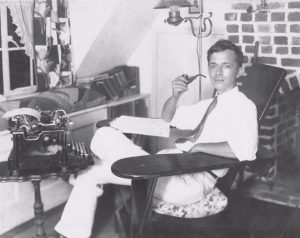 I hope that I have whet your appetite to expand your personal collection of Murray Leinster books or stories. If so, you should head to Mars, Pennsylvania for PulpFest 2021. Fans of genre fiction, original pulp artwork, and vintage pulp magazines will find treasures galore at PulpFest. The convention runs from August 19 through August 22 at the DoubleTree by Hilton Hotel Pittsburgh – Cranberry in Mars. Join us in August for an immersion into the world of the pulps and, hopefully, Murray Leinster.
I hope that I have whet your appetite to expand your personal collection of Murray Leinster books or stories. If so, you should head to Mars, Pennsylvania for PulpFest 2021. Fans of genre fiction, original pulp artwork, and vintage pulp magazines will find treasures galore at PulpFest. The convention runs from August 19 through August 22 at the DoubleTree by Hilton Hotel Pittsburgh – Cranberry in Mars. Join us in August for an immersion into the world of the pulps and, hopefully, Murray Leinster.
The great success enjoyed by Street & Smith’s THE SHADOW MAGAZINE led more publishers to introduce their own single-character pulps, beginning in 1933. That year, no less than eight “hero pulps” debuted — THE PHANTOM DETECTIVE, DOC SAVAGE MAGAZINE, NICK CARTER MAGAZINE, THE LONE EAGLE, G-8 AND HIS BATTLE ACES, THE SPIDER, and PETE RICE MAGAZINE are the best known. The eighth was the short-lived BLACK BAT DETECTIVE MYSTERIES, published by the Berryman Press.
BLACK BAT DETECTIVE MYSTERIES lasted for just six issues, beginning with the October 1933 number. The lead stories for the magazine were all written by Murray Leinster. Pictured above is the December 1933 issue, featuring cover art by John A. Coughlin. The artist is best known for his long run of DETECTIVE STORY MAGAZINE covers.
The series concerns a detective called “The Black Bat” because of the calling cards he leaves behind, featuring the image of a bat. Murray Leinster was one of the first of the hero pulp writers, along with such stalwarts as Lester Dent, Robert J. Hogan, and Norvell W. Page.
One of Leinster’s early specialties was in the field of adventure stories and the sub-specialty of the jungle adventure story. In addition to writing adventure yarns for DANGER TRAILS, he also penned similar stories for ACE-HIGH MAGAZINE, ADVENTURE, FRONTIER STORIES, TOP-NOTCH MAGAZINE, and other pulps, including Street & Smith’s THE THRILL BOOK. Pictured above is the October 15, 1919 issue — with cover art by John Reynolds — and featuring Leinster’s novella “Juju.”
As mentioned above, Leinster’s first published science fiction story, “The Runaway Skyscraper,” appeared in the February 22, 1919 issue of ARGOSY AND RAILROAD MAN’S MAGAZINE. The cover art is by Fred W. Small, an artist who worked exclusively for the Munsey magazines.
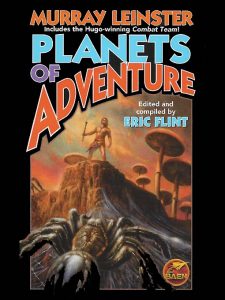 Murray Leinster introduced the premise of parallel realities and alternate histories in his story, “Sidewise in Time,” published in the June 1934 issue of Street & Smith’s ASTOUNDING STORIES. The cover art was by Howard V. Brown, one of the leading artists for the science fiction pulps.
Murray Leinster introduced the premise of parallel realities and alternate histories in his story, “Sidewise in Time,” published in the June 1934 issue of Street & Smith’s ASTOUNDING STORIES. The cover art was by Howard V. Brown, one of the leading artists for the science fiction pulps.
In 1957, Leinster introduced his Med Service series, beginning with “Ribbon in the Sky,” published in the June 1957 issue of ASTOUNDING SCIENCE FICTION. Pictured above is the front cover for the December 1964 number of ANALOG SCIENCE FACT — SCIENCE FICTION, illustrating Leinster’s novella “Plague on Kryder II.” It is the seventh of eight stories in the series. The cover art is by Robert Swanson, an artist who seemed to be active in the digest industry during the 1950s and 60s.
The man in the undated, black-and-white photograph is, of course, Will F. Jenkins, a.k.a. Murray Leinster. The photograph is courtesy of the Literary Estate of Murray Leinster. The photographer is not known.
Despite originally appearing in 1920 – 21, Murray Leinster’s novellas, “The Mad Planet” and “Red Dust” are still thrilling readers today. Together with “Nightmare Planet,” they were turned into a “fix-up novel” entitled FORGOTTEN PLANET, published in 1954 by Gnome Press. Ace Books published the first paperback edition in 1961. It was reprinted as volume 6 in Crown Publishing’s “Classics of Modern Science Fiction” in 1984. Carroll & Graf issued another paperback edition in 1990. In 2003, Baen Publishing collected FORGOTTEN PLANET into a collection of Leinster stories entitled PLANETS OF ADVENTURE. This paperback volume featured cover art by Bob Eggleton. The collection was reissued as an e-book in 2004 by Baen and as an audiobook in 2020. In between, there were numerous “instant print” editions released by various publishers. Even after a century, Leinster’s stories continue to thrill readers of speculative fiction.
A professional journalist and illustrator with over thirty years of experience, Sara Light-Waller is an accomplished new-pulp fiction author/illustrator with two books out and more on the way. She is also the winner of the 2020 Cosmos Prize for her illustrated short story, “Battle at Neptune.” A huge pulp fan, Sara is especially fond of science fiction pulps. She is also a member of the PulpFest organizing committee, a regular contributor to our homepage and THE PULPSTER, and often reads for PulpFest‘s “New Fictioneers” program.

